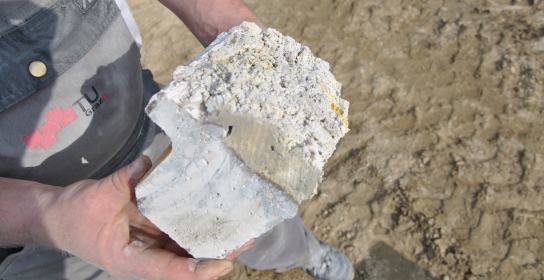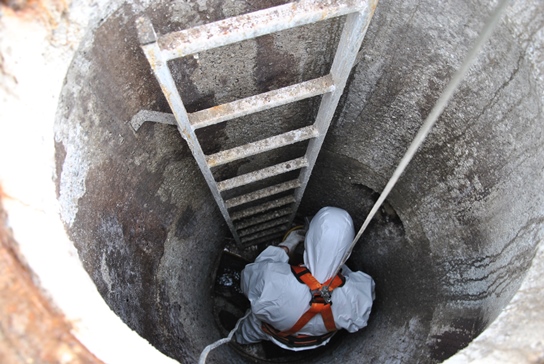Researchers from the Graz University of Technology (TU Graz) (Graz, Austria) believe geopolymer-based concrete (GPC) could offer superior protection against microbiologically influenced corrosion (MIC) for wastewater infrastructure relative to traditional ordinary Portland cement (OPC).
According to the researchers, the geopolymer concretes offer superior resistance to acids, abrasions, and are less permeable than OPC-based materials, which are formed via cement hydration reactions. These calcium-rich hydration products are generally acid dissolvable, the researchers explain, thus making OPC prone to corrosion from acid attack.
“[MIC] often corrodes the conventional types of concrete used in wastewater treatment plants at a rate of 1 cm or more per year,” says Cyrill Grengg, a professor at TU Graz’s Institute of Applied Geosciences and a leader of the research team.1 “Accordingly, the concrete elements can be destroyed in a matter of only a few years, causing significant damage to wastewater systems. Closing the manhole covers and looking the other way is not the answer.”
They say their research shows that concrete made from geopolymers can have a greater lifespan than conventional concretes, thus extending the service life of wastewater assets.
Acid Attack Process in OPC
With OPC, microbial-induced acid corrosion in wastewater treatment facilities usually results from a sequence of biogenic sulfate reduction reactions, followed by reoxidation. Initially, the researchers explain, sulfate in pressurized pipelines or standing water is reduced by bacteria under oxygen-free conditions, thus forming hydrogen sulfide (H2S).

From there, the H2S gas escapes into the sewer air and diffuses into sewer pipes and manholes. Autotrophic bacteria on the walls of the concrete then oxidize the H2S into sulfuric acid (H2SO4), which reacts with the concrete’s construction elements.
“This leads to the vigorous formation of a biofilm on the surface of the concrete, a reduction of the pH value to below two,” says Günther Koraimann, a research team leader and professor at Tu Graz’s Institute of Molecular Biosciences. “In other words, [it is] highly acidic, and [leads to] extensive formation of new minerals, mainly in the form of gypsum. The combination of these processes results in the rapid destruction of the concrete.”
The researchers investigated the damage from MIC on traditional OPC assets through a series of in-field tests before comparing their statistical results to laboratory findings using geopolymers.
Advantages of Geopolymer Technology
In contrast to OPC, which is formed through hydration reactions, GPC is produced through the polycondensation of aluminosilicates. In this ion-exchange reaction process, materials like blast furnace slag, fly ash, or metakaolin are mixed with alkaline reagent solutions such as sodium- or potassium-soluble silicates to form a hardened, concrete-like texture. These geopolymer materials also offer a lower carbon footprint, potentially making them a “greener” alternative.
According to the researchers, the framework vacancies formed by the dissolution of aluminum are mostly reoccupied by the silicates. This results in an amorphous, highly siliceous framework that is relatively hard but brittle. This undissolved corroded layer can effectively inhibit the process of further corrosion by acting as a barrier to the transport of acid protons.
“Thus, compared to the neutralization capacity achieved by dissolution of hydration products, the permeability of the acidified [geopolymer] layers governs the rate of further ingress of acids,” the researchers write. In essence, the microorganisms that trigger the initial oxidation process in OPC corrosion cases and the formation of H2SO4 are unable to settle on the surface, the researchers say
The alkali-activated specimens produce a layer of aluminosilicate gel, which studies have shown remains in place even after decalcification and offers chemical stability even at a low pH, they explain. X-ray diffraction (XRD), electron microscopy, and mechanical tests have been conducted on the acid resistance of a metakaolin material exposed to 0.01 M of hydrochloric acid (HCl) for 28 days, finding that the network structure remained practically intact while still showing excellent binding properties.
The researchers believe the addition of antimicrobial cation additives could further help in reducing bacterial colonization, though they acknowledge more research is needed.
Further Testing Needed
Going forward, the researchers say more thermodynamic data are needed on the performance of geopolymer concretes in the field before commercial advances can be made on the technology. For example, in the process they described, large variations of aluminum and silicon content are often seen—and researchers would like more data on the results of the varying compositions.

“Lack of data on durability performances and standardization makes the field use of GPC difficult,” the researchers explain.
The cation exchange property of geopolymers can also have a negative effect, they explain, such as having alkalis leach out from the geopolymer materials to form alkali sulfides in MIC environments on the concrete surface. This process is known as efflorescence.
The leaching of alkalis also lowers the pH inside the geopolymer, which researchers say could lead to corrosion initiation of the reinforcing steel bar. As a result, they believe new design strategies may be needed to reduce the amounts of alkali activator solutions as well as water content needed to produce denser microstructures. The shrinkage and creep of geopolymer materials is also underexplored, the researchers say, adding that it is another important topic worthy of further analysis.
Nonetheless, even considering the relative uncertainty with the GPC process, the researchers believe the vulnerability of traditional concrete to MIC makes further research a priority.
“While the overall process mechanisms and environmental parameters responsible for MIC are fairly well understood, to date, no commercially available concrete can satisfactorily withstand the adverse conditions in such aggressive environments over its projected operating life,” they write. “Accordingly, further research should focus on how to constrain concrete-microorganism interactions.”
Source: TU Graz, www.tugraz.at/en. Contact Cyrill Grengg, TU Graz—email: cyrill.grengg@tugraz.at.
Reference
1 “Combating Sulfuric Acid Corrosion at Wastewater Plants: Graz Scientists Develop New Solution,” TU Graz News, Feb. 22, 2018, https://www.tugraz.at/en/tu-graz/services/news-stories/tu-graz-news/singleview/article/grazer-loesung-gegen-schwefelsaeureangriff-auf-abwasseranlagen/ (March 19, 2018).